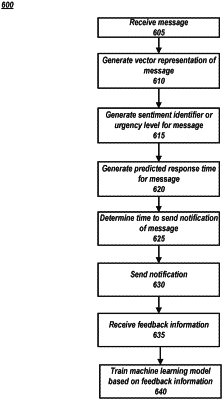| CPC H04L 51/224 (2022.05) [G06F 40/30 (2020.01); H04L 51/02 (2013.01)] | 20 Claims |

|
1. A system for using machine learning to determine a time to send a message notification to a user device, the system comprising:
one or more processors configured to execute computer program instructions that, when executed, cause the one or more processors to perform operations comprising:
receiving a message comprising text and metadata indicating a sender of the message, the user device intended to receive the message, and a timestamp;
generating, via a message embedding model, a vector representation of the message, wherein the vector representation is indicative of the text and the metadata of the message;
inputting the vector representation into a sentiment detection model to obtain a sentiment identifier associated with the message;
inputting the vector representation into an urgency detection model to obtain an urgency level associated with the message;
inputting an indication of the sentiment identifier, the urgency level, the timestamp, and user device information into a response prediction model to obtain a predicted response time for the message indicative of a quantity of time predicted to transpire between a first time at which a notification is received at the user device and a second time at which a response to the message is predicted to be sent;
determining a time to send the message notification to the user device;
sending the notification to the user device;
receiving, from the user device, feedback information indicating a preferred time for receiving the message notification and a second sentiment identifier of the message indicating an interpretation of the message by a user; and
training, based on the feedback information, the sentiment detection model, the urgency detection model, and the response prediction model.
|